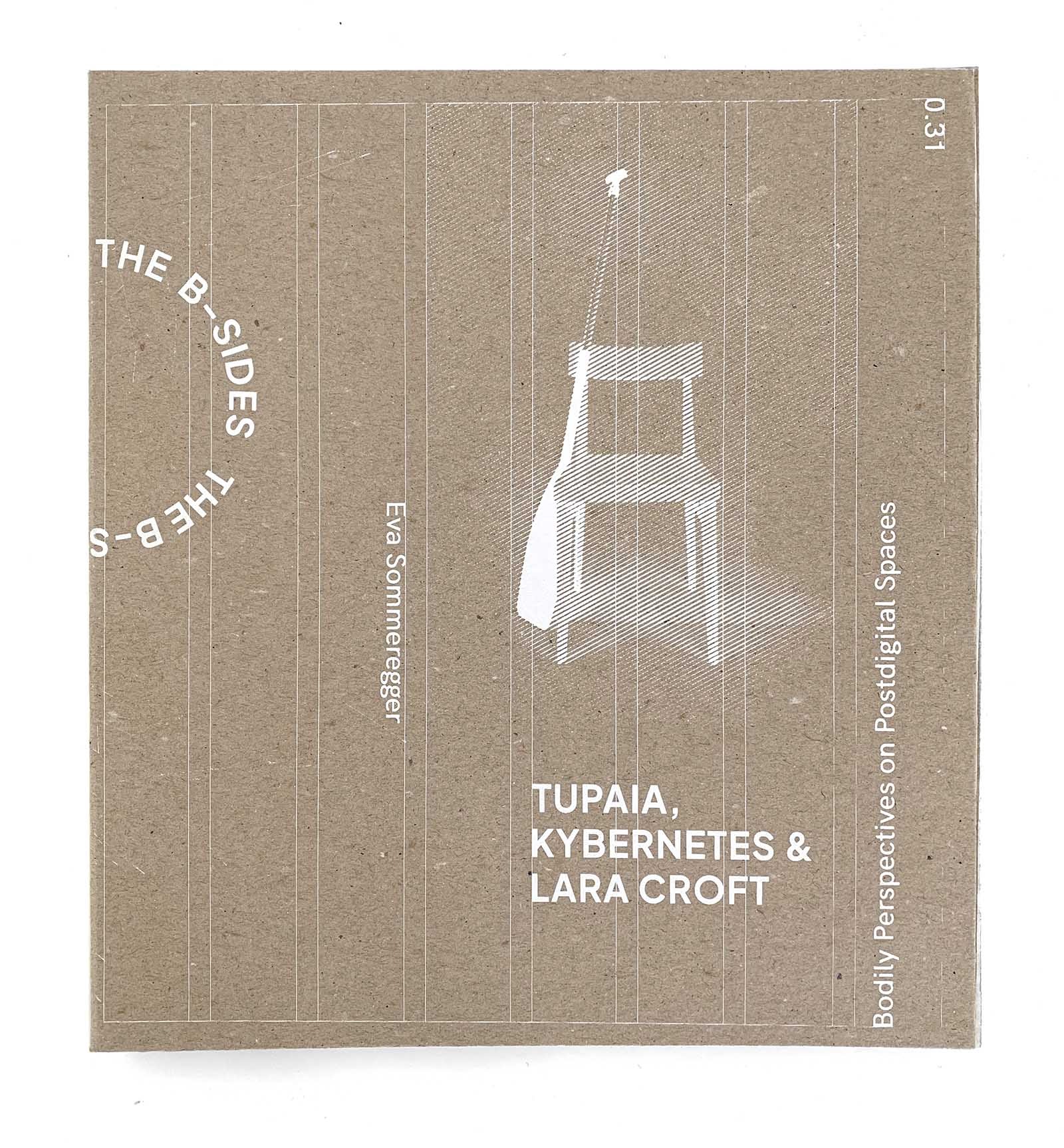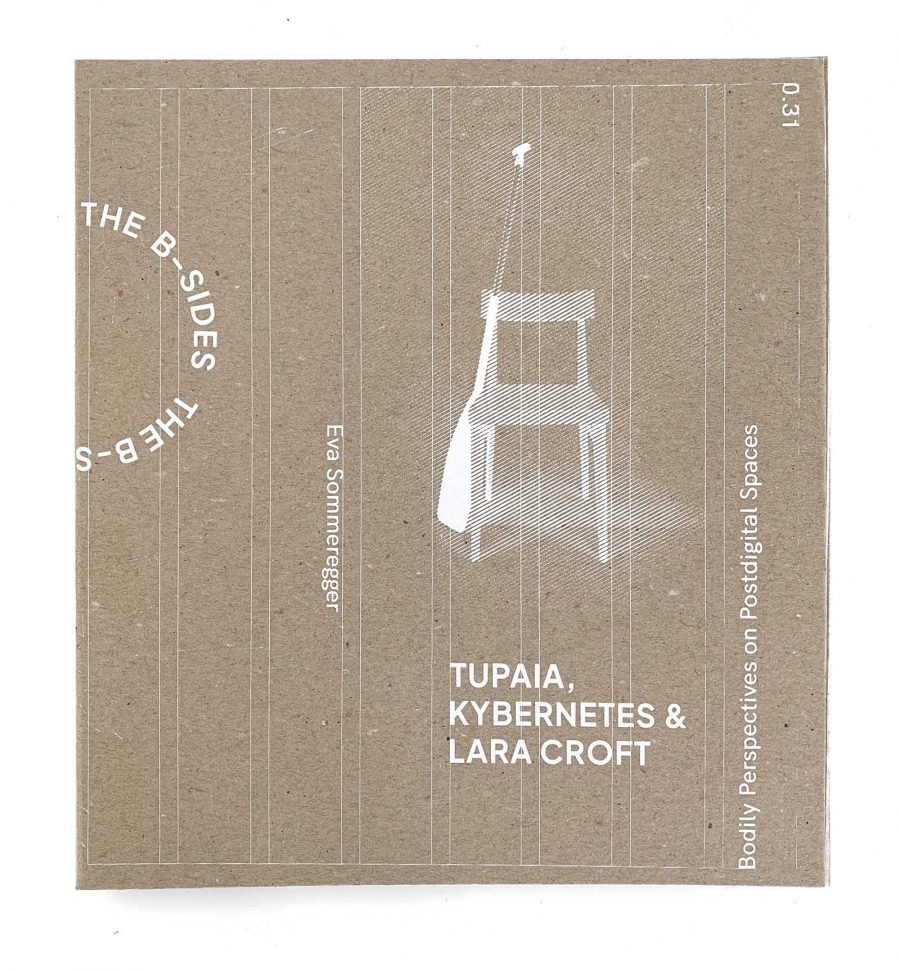artist book, Breite Gasse Publishing, 2022
Using artistic research and spatial philosophy, this book investigates modes of navigation: it juxtaposes archetypal ship-based movements characteristic of the Polynesian navigator Tupaia, the ancient Greek navigator Kybernetes and the avatar of Lara Croft.
The book allows the juxtaposition of the three characters and the creation of new links between them in terms of their specificities around the theme of navigation. A chapter of the book is dedicated to each of the characters, outlining the peculiarities of each character’s lived model of space. The artistic research dwells on practices of enactment and re-enactment to develop alternative readings of avatars, the role of Margaret Mead in second-order cybernetics and oceanic navigation, and to highlight the limitations of Western concepts of space in framing digitally supported practices.
By examining the ways in which the three characters navigate two worlds simultaneously, the focus is on the qualities of the fluid space that emerges. In reference to Shuhei Hokosawa’s Walkman effect, it could be called a Walkman space – a space where a mobile practice creates an intersection between two worlds.
The book materialises in three truly different ways; it exists as a limited edition hand-made screen-printed leporello, a digitally printed colour leporello and a free e-pub, which can be accessed here:
Lara Croft
Lara Croft is a frequent target of feminist media theory critique, which is primarily concerned with the appearance of her body. I propose to shift the discussion from her physical appearance to a critique of Croft as an avatar, i.e. to talk about what she can do, and thus to reconceptualise her space – a space that is both physical and digital – as something reciprocal that leaves avatars with agency, and thus their fated, unchanging, non-interactive, non-learning and option-poor lives.
Kybernetes
In cybernetics, named after kybernetike techne, the art of navigation, we find the idea of a researcher inhabiting two worlds simultaneously – coined by the anthropologist Margaret Mead, one of the most famous US scientists of the mid-century, best known for her field studies in Samoa in the late 1920s. She added the figure of the observer to the existing cybernetic theory of the time, introducing second-order cybernetics. Mead’s Kybernetes adopts from fieldwork the method of participant observation, which assigns to the researching observer a dual existence: one in which one is simultaneously in the field and interacting with it, and one in which one reflects on the field and attempts to grasp it scientifically. Similar to the situation of the Avatar, we find here a superimposition of two worlds. In this case it is the one that is being observed that is superimposed on the one that marks the frame of observation.
Tupaia
Tupaia, a Polynesian priest and navigator, is the central protagonist in a story about the clash between two ways of imagining the world. In Tahiti in 1769, Tupaia boarded the HMS Endeavour, which was under the command of the explorer James Cook on a British expansionist expedition across the Pacific to map unknown territories. Cook let Tupaia navigate the Endeavour for over a month; the British were fascinated by his nautical skills, but could not understand them. According to the limited knowledge we have today, the boat is the fixed element in the oceanic model of the world; during a voyage, islands pass to the right and left, as do currents, constellations, positions of the sun and moon, flocks of birds, cloud formations. The routes go from island to island and are passed on from generation to generation through songs. The British were very interested in this knowledge and decided to create a map together with Tupaia. The map was a mystery to scholars until two literary scholars, Lars Eckstein and Anja Schwarz, deciphered it in 2019 by tracing the process of its creation through the crew’s diaries and redrawing the map. In order to understand it, I have redrawn the map too, as a kind of re-enactment.
The map of Tupaia superimposes two ideas of navigation: one that is enacted and one that is mapped. In order to decipher it, it is necessary to understand both, especially the bearing of a boat, i.e. the direction in which it is heading. Tupaia had observed that the compass played an important role for Europeans in determining direction, and so he built his map for them on compass points that formed routes from one island to the next. These connections, which a navigator would construct, are not shown in the versions of the map we know. The status of the map is interesting. It differs from other artefacts displayed in ethnographic collections, where the dominance of a so-called dominant culture over a dominated, so-called less developed culture is presented through the display of trophies.
Tupaia’s map is not suitable as a trophy because (1) the original has been lost, undermining the competence of the so-called dominant culture to preserve objects intact. (2) It is too complex and has not been understood for a long time, showing the lack of Western knowledge and understanding. (3) To make the map understandable, a re-enactment is needed, as the literary scholars have done, redrawing it step by step, island by island – re-enactments are often used subversively in art to question and reinterpret traditional interpretations of history.
All three versions of the book are written by Eva Sommeregger and published by Breite Gasse Publishing, 2022:
The B-Sides. Tupaia, Kybernetes and Lara Croft, ISBN 978-3-9504111-9-5, the handmade screen-printed leporello edition, printed on both sides of a 6.7 metre scroll (edition of 16, 4 artist prints)
Tupaia, Kybernetes and Lara Croft. Bodily Perspectives on Postdigital Spaces, ISBN 978-3-9505219-1-7, the print-on-demand physical edition, comes in colour and features a contextualising text running as a single line across the bottom of the 13.4 metre long leporello
Tupaia, Kybernetes and Lara Croft. Bodily Perspectives on Postdigital Spaces, ISBN 978-3-9505219-0-0, the digital edition comes in colour and is a green open access publication
please find here the different open access formats: pdf, epub, html
The book was financially supported by the Austrian Federal Ministry of Art, Culture, Public Service and Sport (BMKOES) and the Magistrate for the Arts of the City of Vienna (MA7). It was It was first presented in a lecture at Depot, Kunst und Diskussion, Vienna, on 31st January, 2022.




A great read. An insightful and unapologetic re-evaluation of the avatar, presented as both symptomatic of our times and having a long lineage. The approach throughout persists with dualist explorations, never offering a singular attitude to any one aspect of the study, rooted in what appears at first to be a contemporary condition, but is then unpacked as having a rich history that intersects areas such as navigation and cybernetics. The human body is central at all times, with the characters of the text becoming avatars for the reader, as we somehow become entangled with these numerous re-mappings and re-enactments of past, and persistent, world models. The three documents, themselves navigable experiences that can be undertaken individually or as a suite of interconnected texts, are really rather beautiful.